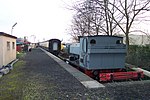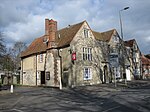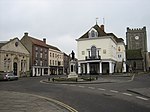Cholsey and Wallingford Railway
1861 establishments in EnglandEngvarB from May 2017Heritage railways in OxfordshireRail transport in BerkshireRail transport in Oxfordshire ... and 4 more
Railway companies disestablished in 1872Railway companies established in 1861Railway lines opened in 1866Wallingford, Oxfordshire

The Cholsey and Wallingford Railway is a 2+1⁄2-mile (4 km) long standard gauge heritage railway in the English county of Oxfordshire. It operates along most of the length of the former Wallingford branch of the Great Western Railway (GWR), from Cholsey station, 12 miles (19 km) north of Reading on the Great Western Main Line, to a station on the outskirts of the nearby town of Wallingford.
Excerpt from the Wikipedia article Cholsey and Wallingford Railway (License: CC BY-SA 3.0, Authors, Images).Cholsey and Wallingford Railway
Tudor Close, South Oxfordshire Winterbrook
Geographical coordinates (GPS) Address Nearby Places Show on map
Geographical coordinates (GPS)
| Latitude | Longitude |
|---|---|
| N 51.59769 ° | E -1.13472 ° |
Address
Tudor Close
Tudor Close
OX10 9GQ South Oxfordshire, Winterbrook
England, United Kingdom
Open on Google Maps








